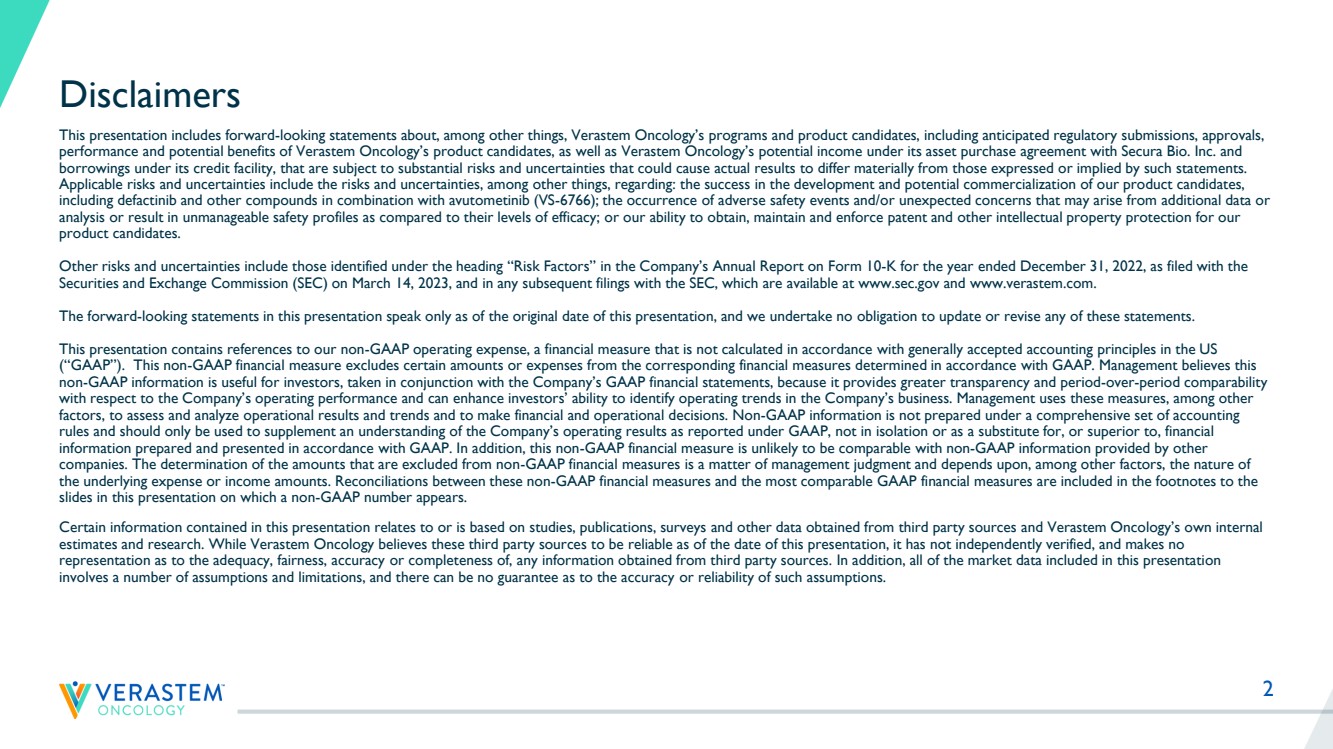
| 2
Disclaimers
This presentation includes forward-looking statements about, among other things, Verastem Oncology’s programs and product candidates, including anticipated regulatory submissions, approvals,
performance and potential benefits of Verastem Oncology’s product candidates, as well as Verastem Oncology’s potential income under its asset purchase agreement with Secura Bio. Inc. and
borrowings under its credit facility, that are subject to substantial risks and uncertainties that could cause actual results to differ materially from those expressed or implied by such statements.
Applicable risks and uncertainties include the risks and uncertainties, among other things, regarding: the success in the development and potential commercialization of our product candidates,
including defactinib and other compounds in combination with avutometinib (VS-6766); the occurrence of adverse safety events and/or unexpected concerns that may arise from additional data or
analysis or result in unmanageable safety profiles as compared to their levels of efficacy; or our ability to obtain, maintain and enforce patent and other intellectual property protection for our
product candidates.
Other risks and uncertainties include those identified under the heading “Risk Factors” in the Company’s Annual Report on Form 10-K for the year ended December 31, 2022, as filed with the
Securities and Exchange Commission (SEC) on March 14, 2023, and in any subsequent filings with the SEC, which are available at www.sec.gov and www.verastem.com.
The forward-looking statements in this presentation speak only as of the original date of this presentation, and we undertake no obligation to update or revise any of these statements.
This presentation contains references to our non-GAAP operating expense, a financial measure that is not calculated in accordance with generally accepted accounting principles in the US
(“GAAP”). This non-GAAP financial measure excludes certain amounts or expenses from the corresponding financial measures determined in accordance with GAAP. Management believes this
non-GAAP information is useful for investors, taken in conjunction with the Company’s GAAP financial statements, because it provides greater transparency and period-over-period comparability
with respect to the Company’s operating performance and can enhance investors’ ability to identify operating trends in the Company’s business. Management uses these measures, among other
factors, to assess and analyze operational results and trends and to make financial and operational decisions. Non-GAAP information is not prepared under a comprehensive set of accounting
rules and should only be used to supplement an understanding of the Company’s operating results as reported under GAAP, not in isolation or as a substitute for, or superior to, financial
information prepared and presented in accordance with GAAP. In addition, this non-GAAP financial measure is unlikely to be comparable with non-GAAP information provided by other
companies. The determination of the amounts that are excluded from non-GAAP financial measures is a matter of management judgment and depends upon, among other factors, the nature of
the underlying expense or income amounts. Reconciliations between these non-GAAP financial measures and the most comparable GAAP financial measures are included in the footnotes to the
slides in this presentation on which a non-GAAP number appears.
Certain information contained in this presentation relates to or is based on studies, publications, surveys and other data obtained from third party sources and Verastem Oncology’s own internal
estimates and research. While Verastem Oncology believes these third party sources to be reliable as of the date of this presentation, it has not independently verified, and makes no
representation as to the adequacy, fairness, accuracy or completeness of, any information obtained from third party sources. In addition, all of the market data included in this presentation
involves a number of assumptions and limitations, and there can be no guarantee as to the accuracy or reliability of such assumptions. |